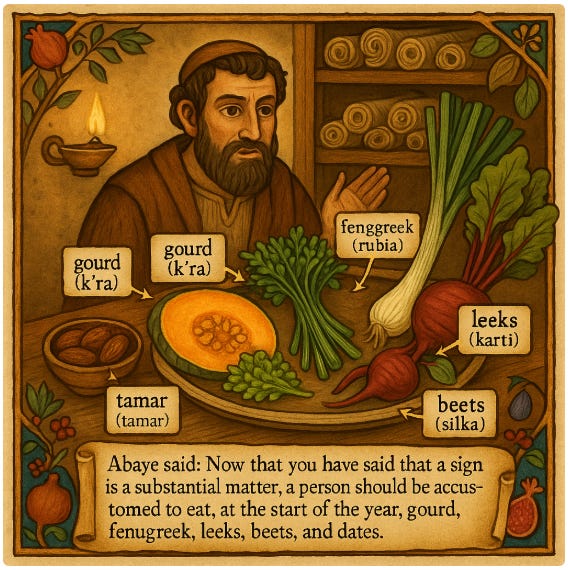Girsaot for Simanim on Rosh Hashanah
This was a recent daf, and is indeed inyanei deYoma — or rather, inyanei de-Rosh Hashanah. Towards the end of Horayot (12a), we had this:
הַאי מַאן דְּבָעֵי לְמִיפַּק [לְאוֹרְחָא] וּבָעֵי לְמִידַּע אִי (חָזַר) [הָדַר] וְאָתֵי לְבֵיתָא, אִי לָא – נֵיקוּם בְּבֵיתָא דְּחַבָּרָא, אִי חָזֵי בָּבוּאָה דְבָבוּאָה לִידַּע דְּהָדַר וְאָתֵי לְבֵיתֵאּ. וְלָאו מִלְּתָא הִיא, דִּלְמָא חָלְשָׁא דַּעְתֵּיהּ, וּמִיתְּרַע מַזָּלֵיהּ. אָמַר אַבָּיֵי: הַשְׁתָּא דְּאָמְרַתְּ סִימָנָא מִילְּתָא הִיא, [לְעוֹלָם] יְהֵא רָגִיל לְמִיחְזֵי בְּרֵישׁ שַׁתָּא קָרָא וְרוּבְּיָא, כַּרָּתֵי וְסִילְקָא וְתַמְרֵי.
One who seeks to embark on a journey and wishes to know if he will return and come to his home or if he will not, let him go to a dark [daḥavara] house. If he sees the shadow of a shadow he shall know that he will return and come home. The Sages reject this: This omen is not a significant matter. Perhaps he will be disheartened if the omen fails to appear, and his fortune will suffer and it is this that causes him to fail. Abaye said: Now that you said that an omen is a significant matter, a person should always be accustomed to seeing these on Rosh HaShana: Squash, and fenugreek, leeks, and chard, and dates, as each of these grows quickly and serves as a positive omen for one’s actions during the coming year.
There is a dispute among scholars whether Abaye was responding to the person speaking immediately before, or responding to the brayta about anointing a king by a stream.
The person above is Rabbi Ami, a third-generation Amora from the Land of Israel who was Rabbi Yochanan’s student. So even though Abaye is in Bavel, it makes sense for him to have heard Rabbi Ami’s statement. There were nechutei, Amoraim bringing reports of halachic positions from the Land of Israel.
Still, from a content point of view, the brayta is a much better match. Rabbi Ami’s pronouncements seem to border on forbidden nichush, making decisions about what to do in business on the basis of these omens. The brayta is more pareve, as it being a nice sign / omen for the start of a monarchy. So too, for the start of a year. Therefore, we are really skipping over Rabbi Ami and having Abaye respond directly to the brayta.
There is a parallel sugya in Keritot 6a, with so much matching content that it seems impossible to tell which is the primary sugya and which the secondary parallel. That reads, in our printed text:
אָמַר אַבָּיֵי: הַשְׁתָּא דְּאָמְרַתְּ סִימָנָא מִילְּתָא הִיא, יְהֵא רְגִיל אִינִישׁ לְמֵיכַל רֵישׁ שַׁתָּא קָרָא וְרוּבְּיָא, כַּרָּתֵי, סִילְקָא וְתַמְרֵי.
Abaye said: Now that you have said that a sign is a substantial matter, a person should be accustomed to eat, at the start of the year, gourd, fenugreek, leeks, beets, and dates, as each of these grow and multiply quickly, which is a good omen for the deeds of the upcoming year.
There is a slight divergence between these two sugyot, in that Keritot has לְמֵיכַל, to eat, while Horayot has לְמִיחְזֵי, to see. However, this is not really a dispute between sugyot but a dispute between manuscripts. Because manuscript variants in both Keritot and Horayot have instances of each. Though note that Munich 95, which is our only comprehensive manuscript that covers the entire Talmud, is inconsistent between these two sugyot, so if you want, sure, it is a dispute between sugyot.
I can see a few reasons for the shift between these variants.
An oral error between לְמֵיכַל / לְמִיחְזֵי. That would indicate an Ashkenazic pronunciation, between the chaf and the chet!
A theological tension. Even though Rabbi Ami said the thing bordering on nichush, within Abaye, there is a big difference between taking an action of eating to effectuate something and simply having the foods present on the table.
Related, the question whether we are binding to Rabbi Ami or to the brayta. The looking seems more aligned to the brayta and the eating to Rabbi Ami.
It is admittedly a toss-up. However, given that this is a theological case of lectio difficilior potior, I would side with eating. That is, the more theologically problematic one would be taking the action, and so merely looking at it seems like an adjustment that some Rishon could make.
Again, here are my modern simanim for Rosh Hashanah.
Modern Simanim for Rosh Hashanah
Here is a list of simanim for modern times, put together by yours truly. There’s still time to go shopping…



